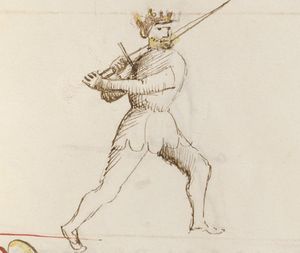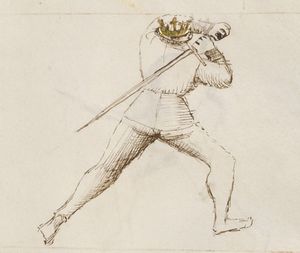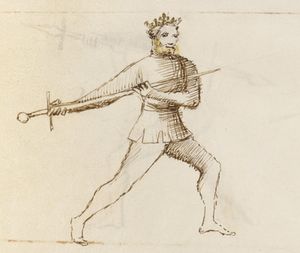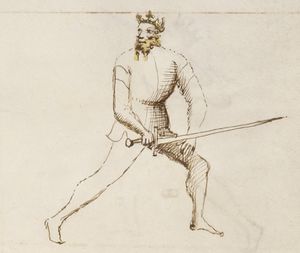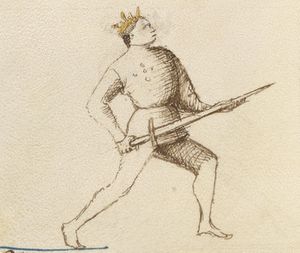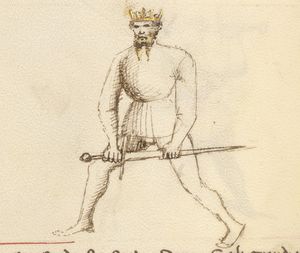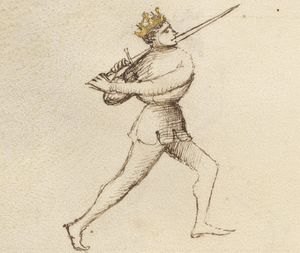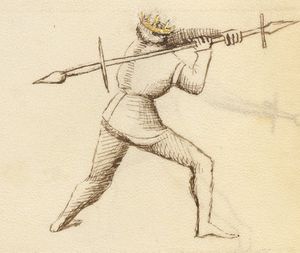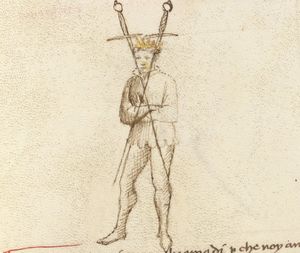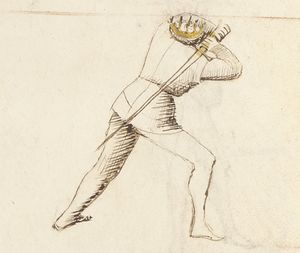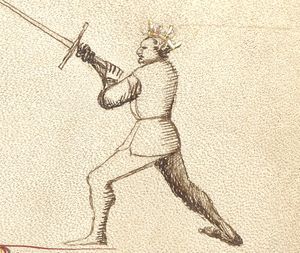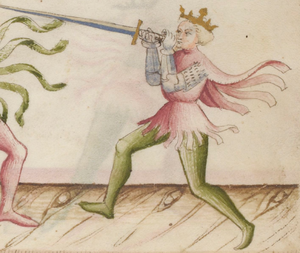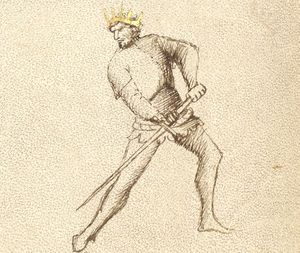|
|
You are not currently logged in. Are you accessing the unsecure (http) portal? Click here to switch to the secure portal. |
Fiore de'i Liberi/Sword in Two Hands
Images |
Images |
Morgan Transcription |
Getty Transcription |
||||
|---|---|---|---|---|---|---|---|
[1] We are two guards that are similar to each other, and yet each one is a counter to the other. And for all other guards in this art, guards that are similar are counters to each other, with the exception of the guards that stand ready to thrust—the Long Guard, the Short Guard and the Middle Iron Gate. For when it is thrust against thrust the weapon with the longer reach will strike first. And whatever one of these guards can do so can the other. And from each guard you can make a “turn in place” or a half turn. A turn in place is when without actually stepping[1] you can play to the front and then to the rear on the same side. A half turn is when you make a step forwards or backwards and can switch sides to play on the other side from a forwards or backwards position. A full turn is when you circle one foot around the other, one remaining where it is while the other rotates around it. Furthermore you should know that the sword can make the same three movements, namely stable turn, half turn and full turn. Both of these guards drawn below are named the Guard of the Lady. Also, there are four types of movement[2] in this art, namely passing forwards, returning,[3] advancing,[4] and withdrawing.[5] [Text spans both images.] |
[22r-a] ¶ Noii semo doi guardie una si fatta che l'altra, e una e contraria del'altra. e zaschuna altra guardia in l'arte una simile del'altra si'e contrario salvo le guardie che stano in punta zoe posta lunga e breve e meza porta di ferro che punta per punta la piu lunga fa offesa inançi. E ço che po far una po far llaltra. E zaschuna guardia po fare volta stabile e meza volta. Volta stabile si'e che stando fermo po zugar denanci e di dredo de una parte. Meza volta si'e quando uno fa un passo o inanzi o indredo, e chossi po zugare del'altra parte denanzi e di dredo. Tutta volta si'e quan uno va intorno uno pe cum l'altro pe, l'uno staga ferma e l'altro lo circundi. E perzo digo che la spada si ha tre movimenti, çoe volta stabile, meza volta, e tutta volta. E queste guardie sono chiamate l'una e l'altra posta di donna. Anchora sono ·ⅲⅰ· cose in l'arte, çoe passare, tornare, Acressere, e discressere. |
||||||
[2] Six Masters we are, and we dispute one to another For throwing I am well prepared, We are six guards and each of us is different from the other, and I am the first to speak of my purpose. My method is to throw my sword. The other guards follow after me. I believe they will tell you themselves about their particular virtues. |
[22r-c] ¶ Voii[!] semo Seii guardie. & una non e simile del'altra. E io son la primera che digo mia rasone. De lanzar mia spada questa e mia condicione. Le altre guardie che de mi sono dredo, dirano le lor virtude come io credo. |
[17b-t] Sie[!] magistri semo l'un da'l'altro devisati [17b-a] Per alançare e son ben aparichiato |
|||||
[3] Against the grip of hand and also the throw, I am a good guard, in armor or without armor, and against a spear or a sword thrown from the hand, I am confident I will not be harmed, because I know how to beat them aside and thus evade them. |
[22r-d] ¶ Io son bona guardia in arme e senza, e contra lanza e spada zitada fora di mano, Che io le so rebattere e schivarle. Pero me tegno certo che non me pon far male. |
[17b-b] Contra tegner de man e anchora de lançare |
|||||
[4] In order to strike farther and to step stronger I am the guard to use if you want to extend a long thrust, because my grip on the sword increases its reach. I am good to use against you if you and I are armored, because I can make a quick thrust to the front which will not miss you. |
[22v-a] ¶ E son guardia de trar una longa punta tanto che lo mio mantener di spada de longeza monta. E son bona d'andare contra uno che sia luii e mi armato. Per che io habia curta punta denanzi io non saro inaganato. |
[17b-c] Per trare piu longo e per piu forte passar |
|||||
[5] Against dagger and against sword, armored I am a good guard against sword, axe and dagger if I am armored, because I grip the sword with my left hand at the middle. And this is particularly useful against the dagger, which can do more harm to me at close range than the other weapons. |
[22v-b] ¶ Io son bona guardia contra spada azza e daga siando armado. Per che io tegno la spada cum la man mancha al mezo. E'llo faço per fare contra la daga che me po fare dele altre arme pezo. |
[17b-d] Contra daga e contra spada armato |
|||||
[6] This grip is the noble Stance of the Queen: I am named the Guard or Post of the Lady, and[6] I am different from the four[7] sword guards[8] that came before me, even though they are themselves different from each other.[9] And although the next guard that opposes me seems to be my guard also, you will note that I am not using my sword reversed as a poleaxe, whereas that is how he is using his.[10] |
[22v-c] ¶ Guardia e posta di donna son chiamata per che cum queste altre prese de spada e son divisada, che una non e tal presa che l'altra, ben che questa che m'e contra mi pare la mia guardia. Se non fosse forma de Azza che la spada si intrada. |
||||||
[7] This sword I use for a sword and an axe:[12] This sword is being used as both a sword and a poleaxe. And its great force can stop any attack from a lighter weapon. This guard is also the High Guard of the Lady, who with her skill can fool the other guards, because you will think she is going to attack you with a strike, but instead she will attack you with a thrust. All I have to do is raise my arms above my head, and I can then quickly launch a thrust at you. |
[22v-d] ¶ Questa spada si'e spada & Azza. E gli grandi pesi gli licieri forte impaza. Questa anchora posta de donna la soprana, che cum le soi malicie le altre guardie spesso ingana, Per che tu crederai che traga de colpo io traro di punta. Io non ho altro a fare che levar gli brazzi sopra la testa. E posso buttar una punta, che io l'o presta. |
[17b-f] Questa spada me scusa per spada e per aza |
|||||
|
[8] Downward Blows We are downward blows and we dispute We are the downward blows.[13] In this art our method is to cut with precision[14] from the teeth down to the knee. And we can easily end up in any of the low guards. We are highly effective[15] in breaking the other guards, and with each blow we leave a trail[16] of blood. We downward blows strike fast, and thereafter we return to our guard back the way we came. |
· Colpi Fendenti ·
[23r-a] ¶ Noii semo fendenti & in l'arte façemo questione de fender gli denti e rivar alo zinochio cum rasone. E ogni guardia che si fa terrena, D'una guardia in l'altra andamo senza pena. E rompemo le guardie cum inzegno. E cum colpi fazemo de sangue segno. Noi fendenti dello ferir non avemo tardo. E tornamo in guardia di vargo in vargo. |
[12b-e] Noii semo fendenti, e façemo questione |
|||||
|
[9] Under Blows We are the blows called Under, We are the rising blows, and we go from the knee to the middle of the forehead, following the same path that the downward blows follow. And we return[17] down the same path as we ascend, unless we choose to remain high in the Long Guard. |
· Colpi Sottani ·
[23r-b] ¶ Gli colpi sottani semo noi, e cominzamo alo zinochio, e andamo per meza la fronte per lo camino che fano gli fendenti. E per tal modo che noi montamo per quello camino noii retornamo. Overo che noi remanemo in posta longa. |
[12b-f] Noii semo colpi chiamadi li sotani |
|||||
|
[10] Middle Blows We middle blows go thwarting; We are the middle blows, and we are so-called because we go crosswise through the middle of the path of both the downward blows and the rising blows. And we strike with the true edge of the sword from the right, and with the false edge of the sword from the left. And our path could be anywhere between the knee and the head. |
Colpi mezani
[23r-c] ¶ Colpi mezani semo chiamadi per che noii andamo per mezi gli colpi soprani e sottani. E andamo cum lo dritto taglo dela parte dritta. E dela parte riversa andamo cum lo falso taglio. E lo nostro camino si'e dello zinochio ala testa. |
[13a-a] Noii colpi meçani andamo traverssando |
|||||
|
[11] The Thrusts Thrusts we are, of greatest offense We are the cruel and deadly thrusts. Our target is the body’s center line, and we can strike anywhere between the groin and the forehead. And we thrusts can be made in five ways: two of us can be made from high guards, one from each side, and two can be made from low guards, also one from each side. The fifth one comes from a center line guard, and can be made from Middle Iron Gate, the Short Guard, or the Long Guard. |
Le punte
[23r-d] ¶ Noii semo le punte crudele e mortale. E lo nostro camino si'e per mezo lo corpo cominzando alo petenichio in fin ala fronte. E semo punte de ·Ⅴ· rasone, zoe doii soprane una d'una parte l'altra del'altra. E doii de sotta simile mente un d'una parte e l'altra del'altra. E una di mezo che esse di meza porta di ferro overo di posta lunga e breve. |
[13a-b] Ponte semo de grandissima offensione |
|||||
|
[12] The Iron Gate (Powerful)[18] We are called stances and guards by name, The Full Iron Gate, I am low to the ground Here begin the guards of the two handed sword, of which there are twelve. The first is the low[19] Iron Gate, which is a very strong guard, and a good guard in which to wait for an attack by every kind of hand-held weapon, whatever its length,[20] as long as you have a good sword that is not too long. And from this guard if you make cover with a passing step you move to the Narrow Game.[21] Or you can exchange thrusts, striking home with yours.[22] Or, as you step, you can beat the opponent’s thrust to the ground.[23] And this guard can cover attacks from all angles. |
Here commence the guards of the sword in two hands, and there are 12 guards, and the first is the Full Iron Gate which stands in great strength and is good for awaiting all hand-held weapons, both extended and withdrawn, as long as she has good sword (not one of too much length). She steps with a cover and goes to the narrow, she exchanges thrusts and she delivers her own; she also beats thrusts to the ground and always goes with steps, and against all blows she makes a cover. And whoever joins a brawl with her will make great defense without fatigue. |
[12r-a] Aqui comenzano le guardie de spada a do mane e sono ·ⅻ· guardie, e la prima si e tuta porta di ferro che sta in grande forteza e si e bona da aspetar ogni arma manuale longa, e curta, e pur ch'ello abia bona spada non cura de tropa longheza. Ella passa cum coverte e va ale strette. Ella scambia le punte e le soi ella mette. Anchora rebatte le punte a terra, e sempre va cum passi e de ogni colpo ella fa coverta. E chi in quella gle da briga grande defese fa senza fadiga. |
· Porta di Ferro, pulsativa ·
[23v-a] ¶ Qui cominzano le guardie di spada a doii man. E sono ·ⅻ· guardie. La prima si e tutta porta di ferro che sta in grande forteza, E si e bona d'aspetar ogn'arma manuale longa e curta[24] E pur che'l habia bona spada non curi[!] di troppa longeza. Ella passa cum coverta e va ale strette. Ela scambia le punte e le soii ella mette. Anchora rebatte le punte a terra, e sempre va cum passo e de ogni colpo, ella fa coverta. E chi in quella gli da briga grande deffese fa senza fadiga. |
[18a-t] Poste e guardie chiamare per nome si façemo [18a-a] Tuta porta de fero son la piana terena |
[12v-t] ¶ Nomine quisque vocat[25] situs / et custodia fallax.
| ||
|
[14] The Stance of the Queen on the Right (Powerful) I am the Stance of the Queen, noble and proud This is the Guard of the Lady,[27] from which you can make all seven of the sword’s strikes and cover them too. And from this guard you can break the other guards with the strong blows you can make, and you can also quickly exchange thrusts. Advance your front foot offline, and then pass diagonally with your rear foot. This will take you to a position where your opponent is unprotected, and you will then be able to quickly strike him.[28] |
This is the Stance of the Queen,[29] which can make all seven blows of the sword and can also cover all blows. She breaks the other guards through the great blows that she makes, and she is always ready for the exchange of thrusts: the foot that is in front advances out of the way and the one behind steps to the side. And her companion is made uncovered, and that one can immediately strike him for certain. |
[12r-b] Questa si e posta de donna che po far tuti setti colpi dela spada. E de tuti colpi ella se po covrir. E rompe le altre guardie per grandi colpi che po fare. E per scambiar una punta ella e sempre presta. Lo pe denanci acrese fora de strada, e aquello de dredo passa ala traversa. E llo compagno fa romagner discoverto. E aquello po ferire subito per certo. |
· Posta de donna destraza, pulsativa ·
[23v-b] ¶ Questa si'e posta di donna che po fare tutti gli setti colpi dela spada. E de tutti colpi ella se po crovrire. E rompe le altre guardie per grandi colpi che po fare. E per scambiar una punta ella e sempre presta. Lo pe ch'e denanci acresse fora di strada, e quello di dredo passa ala traversa. E lo compagno fa remagner discoverto, e quello pe ferir subito per certo. |
[18a-b] Io son posta de dona soprana e altera |
[12v-b] ¶ Audax / excelsus / muliebris sum situs. alta | ||
|
[15] The Stance of the Window (Fluid) I am the royal Stance of the True Window This is the Window Guard who is always quick, skillful[30] and deceptive. She is a master at covering and striking. She threatens all opposing guards, whether high guards or low guards. She moves quickly from this guard to other guards to confuse her opponent. And she is a very good guard from which to make powerful thrusts, break the opponent’s thrust or exchange points. |
This is the Stance of the Casement Window on the right, which is always ready with malice and trickery, and she is the Master of covering and of striking and with all the guards she makes her disputes (with the high and with the low). She often goes from one guard to another in order to fool her companion, and she throws great thrusts, and knows how to break and to exchange them—those plays she can make very well. |
[12r-c] Questa si e posta de fenestra dextra che de malicie e inganni sempre e presta, E de covrir e de ferir e lla magistra. E cum tute guardie ella fa questione, e cum le soprane, e cum le terene. E d'una guardia a l'altra ella va spesso per inganare lo compagno. E a meter grande punte e saverle rompere e scambiar. Quelli zoghi ella po bene fare. |
· Posta de Finestra instabile ·
[23v-c] ¶ Questa si e posta di Finestra, che de malicie & inganni sempre la e presta. E de covrir e de ferir ella e magistra. E cum tutte guardie ella fa questione e cum le soprane e cum le terene. E d'una guardia a'l'altra ella va spesso per inganar lo compagno. E a metter grande punte e saver le romper e scambiare, quelli zoghi ella po ben fare. |
[18a-c] Io son posta realle de vera finestra |
| ||
|
[16] The Middle Iron Gate (Stable) The Middle Iron Gate, I am strongest This is Mezzana Porta di Ferro (Half Iron Door), because it stays in the middle and is a strong guard. But, she wants a long sword. She throws strong thrusts and beats with force the swords upwards, and returns with a Fendente for the head or arms, and returns to its guard. But it is called Porta (Door), because it is strong and it is a strong guard that badly it can break without danger, and without coming to the close. |
This is the Middle Iron Gate because she stands in the middle, and she is a strong guard but she doesn't want her sword extended. She throws strong thrusts and beats swords upward with strength, and returns with a downward blow through the head or through the arms and then simply returns to her guard. But she is well-named "gate" because she is strong; she is a strong guard that cannot be broken easily without danger and coming to the narrow. |
[12r-d] Questa e meza porta di ferro perche sta in mezo, e de una forte guardia ma ella non vole longa spada, ella zetta forte punte, e rebatte per forza le spade in erto, e torna cum lo fendent per la testa o per gli brazi, e pure torna in sua guardia. Per zo vene chiamada porta, per che ella e forte. E de forte guardia che male se po rompere senza pericolo a venir ale strette. |
· Porta di ferro mezana, stabile ·
[24r-b] ¶ Questa e mezana porta di ferro per che sta in mezo. & e una forte guardia, ma ella vole longa spada. Ella butta forte punte, e rebatte per forza le spade in erto, e torna cum lo fendente per la testa o per gli brazzi, e pur torna in sua guardia. Pero ven chiamata porta per che la e forte E'de forte guardia che male se po rompere senza periculo e venire ale strette. |
[18a-d] Meçana porta de fero son la forte |
[12v-d] ¶ Ferrea sum fortis / medianaque Janua dicor. | ||
|
[17] The Extended Stance (Fluid) I am the Extended Stance with my short sword This guard is the Long Guard, which is full of deception. She is skilled in probing[32] the guards to see if she can deceive her opponent. If she needs to strike the opponent with a thrust, she is well-suited to do it. As for the opponent’s blows, she knows how to avoid them and then strike back with blows of her own. This guard employs deception more than any other guard. |
This is the Extended Stance which is full of deceit; she probes the other guards to see if she can deceive a companion. If she can strike with a thrust, she knows well how to do it; she voids the blows and she can wound when she is able. More than any other guard, her tactic is deception. |
[12v-a] Questa si e posta longa ch'e piena de falsita. Ella va tastando le guardie se lo compagno po inganar. S'ella po ferire de punta ella lo sa ben fare, gli colpi ella schiva e poi fiere s'ella lo po fare. Piu che le altre guardie le falsitade sa usare. |
· Posta longa, Instabile ·
[24r-a] ¶ Posta longa si'e questa piena di falsita. Ella va tastando le guardie se lo compagno po ingannare. Se ella po ferir de punta la lo sa ben far E gli colpi la schiva, e po fieri s'ella lo po'fare. Piu che le altre guardie, le falsita sa usare. |
[18b-a] Io son posta longa cum mia spada curta |
[13r-a] ¶ Ense brevi maneo. situs attamen hic ego longus | ||
|
[18] The Headband Stance called the Crown (Fluid) The Headband Stance, I am called the Crown; This is the Forehead Guard,[33] called by some instructors[34] the Crown Guard. She is a very good guard for crossing swords,[35] and is also very good against thrusts. If she is attacked with a high thrust, she crosses swords while stepping off line . If she is attacked with a low thrust, she also steps offline, but this time she drives the opponent’s sword to the ground . She can also do other things. For example, in response to a thrust she can pass backwards with the front foot and respond with a downward strike to the head or arms, ending in the Boar’s Tusk, then she can quickly throw a thrust or two with advancing steps, then deliver a downward strike, ending in that same guard. |
This is the Headband Stance, and some Masters call her the Stance of the Crown. She is good at crossing, and she is also good against thrusts because if a point comes attacking upwards, she crosses, stepping out of the way. And she also steps out of the way if a point comes attacking low, beating the thrust to the ground. Again, she can do it differently, such that in the attack of a thrust she returns her foot behind and comes with a downward blow through the head and through the arms and goes to the Boar's Tusk, and then suddenly throws a thrust or two with an advance of her foot and returns with a downward blow from her own guard. |
[12v-b] Questa si e posta frontale e alchuni magistri la chiamano posta di corona. Che per incrosar ella e bona, e per le punte, ella e anchora bona che se la punta gle vene trata erta ella la incrosa passando fora de strada. E se lla punta si ven trata bassa anchora passa fora de strada rebatendo la punta a terra. Anchora po fare altramente, Che in lo trar dela punta torni cum lo pe indredo, e vegna di fendenti per la testa e per gli brazi e vada in dente do zenghiaro e subito[36] bute una punta, o doe cum acreser de pe, e torni[37] di fendent cum quella propria guardia. |
· Posta frontale ditta corona Instabile
[24v-c] ¶ Questa si'e posta frontale, chiamada d'alchuni magistri posta di corona, che per incrosar ella e bona, e per le punte ell'e ancora bona, che se la punta gle ven tratta erta, ella la incrosa passando fuora di strada. E se la punta e tratta bassa, anchora passa fuor di strada rebattendo la punta a terra. Anchora po far altra mente, che in lo trar dela punta torni cum lo pe indredo e vegna da fendente per la testa e per gli brazzi e vada in dente di cengiaro e subito butti una punta o doe cum acresser di pe e torni di fendente in quella propia guardia. |
[18b-b] Posta frontalle e son chiamata corona |
[13r-b] ¶ Frontalis situs ipse vocor / famosa corona. | ||
|
[19] [The Stance of the Queen on the Right] Again, I am the Stance of the Queen against the Boar's Tusk; |
This is the Stance of the Queen, which can make all seven blows of the sword and can also cover all blows. She breaks the other guards through the great blows that she makes, and she is always ready for the exchange of thrusts: the foot that is in front advances out of the way and the one behind steps to the side. And her companion is made uncovered, and that one can immediately strike him for certain. |
[12v-c] Questa si e posta de donna che po tuti gli setti colpi fare della spada fare. E de tuti colpi ella se po covrire. E rompe le altre guardie per grandi colpi che po fare. E per scambiar una punta ella e sempre presta. Lo pe ch'e denanci acrese fora de strada, e aquello de dredo passa ala traversa. E lo compagno fa romagnire discoverto. E aquello po ferir subito per certo. |
[18b-c] Anchora son posta de dona contra dent de zenchiar |
| |||
|
[20] The Wild Boar's Tusk (Stable) I am the strong Stance of the Boar's Tusk. This is the Boar’s Tusk,[39] because it strikes the way the wild boar strikes.[40] Sometimes it makes powerful thrusts from below up into the face, without stepping forward, and it returns along the same path with a downward strike to the arms. Other times as it thrusts the point of the sword high into the face, it advances the front foot forwards, then returns to its guard with a downward strike to the head or the arms. Then it quickly launches another thrust with another advance of the front foot. And this guard can mount a good defense against the Narrow Game. |
This is the Wild Boar's Tusk since the tusk of a wild boar has a similar method of striking. She attacks with great underhand thrusts ending in the face and doesn't move a step, and then returns with a downward blow down to the arms. And sometimes she throws her point to the face and goes with the point high, and in that throw of the point she suddenly advances the foot which is in front and returns to her guard, and immediately throws another thrust with an advance of the foot, and thus defends well against the narrow play. |
[12v-d] Questo si e dente de zenghiar, che dello dente de zenghiar fa simile modo de ferir. Ello tra grande punte, per sotto le mane in fin al volto, e non se move de passo, e torna cum lo fendente, zo per li brazi. E alchuna volta tra la punta al volto, e va cum la punta erta, e in quello butar de punta, ello acrese lo pe ch'e denanzi subito, e torna cum lo fendente per la testa, e per li brazi, e torna in sua guardia, e subito zetta un'altra punta cum acresere de pe, e ben se defende dalo zogo streto. |
· Dente di cenghiaro stabile ·
[24r-d] ¶ Questo si'e dente di zengiaro pero che dello zengiaro prende lo modo di ferire. Ello tra grande punte per sotto man in fin al'volto e no si move di passo, E torna cum lo fendente zo per gli brazzi. E alchuna volta tra la punta al volto, e va cum la punta erta, e in quello zitar di punta ello acresse lo pe ch'e dinanzi subito, e torna cum lo fendente per la testa e per gli brazzi e torna in sua guardia, e subito zitta un'altra punta cum acresser di pe, e ben se defende delo zogo stretto. |
[18b-d] Io son la forte posta de dent de zenchiar |
[13r-d] ¶ Sum situs aprinus audax / et viribus ingens / | ||
|
[21] The Shortened Stance (Stable) I am the Shortened Stance and I hold my sword long; This is the Short Guard that is more effective with a longer sword. It is a deceptive guard but it is risky to wait in. It is constantly moving, trying to see if it can enter with a thrust and a step against the opponent. And this guard is more effective in armor than without armor. |
This is the Shortened Stance, which wants a long sword, and she is a malicious guard which doesn't have stability. Also, she always moves and watches to see if she can enter with her point and with a step against her companion, and more appropriate is this guard in armor than without armor. |
[13r-a] Questa si e posta breve che vole longa spada, ed e una maliciosa guarda che non ha stabilita. Anche sempre se move, e guarda se po intrar cum punta e con passo contra lo compagno, e piu e apropiada tal guardia in arme che senza arme. |
· Posta breve stabile ·
[24r-c] ¶ Questa si e posta breve che vole longa spada & e maliciosa guarda che non a stabilita. Anche sempre si move e vede se po entrar cum punta e cum passo contra Lo compagno. E piu e apropiada tal guardia in arme che senz'arme. |
[19a-a] Io son posta breve e o de spada lungeça |
| ||
|
[22] The Stance of the Queen on the Left (Powerful) I am the left Stance of the True Window; This is the Guard of the Lady on the left, and she is always quick to cover or strike. She generates powerful blows and easily breaks the thrust, driving it to the ground. Also, because of her skill in traversing, she can quickly enter into the Narrow Game, a game she is very familiar with. |
This is the Stance of the Queen on the left, and she is always ready to cover and to strike. She makes great blows and breaks the thrusts, beating them to the ground, and she enters into the narrow play by knowing how to thwart. Such a guard knows well how to make these plays. |
|
· Posta di donna la sinestra, pulsativa ·
[23v-d] ¶ Questa si e posta di donna la senestra, che de coverte e de ferir, ella e sempre presta. Ella fa grandi colpi e rompe le punte, e sbattele a terra. E intra in lo zogho stretto per lo suo saver traversare. Questi zogi tal guardia sa ben fare. |
[19a-b] Io son la stancha posta de vera finestra |
| ||
|
[23] The Stance of the Long Tail (Stable) Stance of the Long Tail, I am extended to the ground This is the Long Tail Guard Guard that extends behind you down to the ground. She can attack with a thrust, and can also move forwards to cover and strike. And if she passes forward while striking downwards she can easily enter the Narrow Game. This is a good guard to wait in, because you can quickly transition from it into other guards. |
This is the Stance of the Long Tail which is extended toward the ground. She can thrust the point behind and she can cover and strike in front, and if she steps forward and attacks with a downward blow, into the narrow play she enters without failure. And such a guard is good for waiting, because from her someone can enter into the others quickly. |
[13r-c] Questa si e posta de coda longa ch'e distesa in terra de dredo ella po mettere punta, e denanci po covrir e ferir. E s'ello passa innanci e tra delo fendente. In lo zogo stretto intra senza falimento. Che tale guardia e bona per aspetare. Che de quella in le altre tosto po intrare. |
· Posta di choda longa stabile ·
|
[19a-c] Posta de coda lunga son in terra destesa |
| ||
|
[24] The Two-Horned Stance (Fluid) I make myself called the Stance of the Anvil This is the Two Horned Guard, which is held so strongly locked in position that its point cannot be moved off the center line . And this guard can do all of the things that the Long Guard can do. And the same is true of the Window Guard and the Forehead Guard. [In the Novati, the left hand is not reversed; this is likely due to an error on the part of the artist hired to clean up the Pisani Dossi manuscript images before publication.] |
This is the Stance of the Two-Horned Anvil, which is so strongly enclosed that she always remains with her point toward the middle of the way. And she can do that which the Extended Stance can do, and this can similarly be said of the Stance of the Window and the Headband Stance. |
[13r-d] Questa e posta de bicorno che sta cosi serada che sempre sta cum la punta per mezo la strada E aquello che po fare posta longa po far questa E similmente dico de posta di fenestra, e posta frontale. |
· Posta di Bichorno instabile ·
[24v-b] ¶ Questa e posta di bicorno che sta cossi serada, che sempre sta cum la punta per mezo dela strada. E quello che po fare posta longa, po fare questa. E simile mente dico de posta di Fenestra. e di posta frontale. |
[19a-d] Posta de bicornio io me faço chiamar |
| ||
|
[25] The Stance of the Boar's Tusk in the Middle (Fluid) This is the Middle Boar’s Tusk, so named because the boar has two tusks, one low and this one in the middle, by which I mean this one stays on the center line. And the Middle Boar’s Tusk can do whatever the Low Boar’s Tusk can do. Just as the wild boar strikes diagonally with its tusks, so you strike diagonally with your sword, in such a way as to displace[48] your opponent’s sword, from which position, having uncovered your opponent, you can launch thrusts, or destroy his hands, head or his arms. |
· Posta di dente zenchiaro mezana, stabile · [24v-d] ¶ Questo si'e dente di cengiaro lo mezano, e per ço che sono doii denti di zengiaro l'uno tutto, l'altro si'e mezo, pero e ditto mezo, per zo ch'ello sta in mezo dela persona, e zo che po fare lo tutto dente, po fare lo mezo dente. E per modo che fieri lo zengiaro a la traversa, per tal modo se fa cum la spada che sempre fieri cum la spada ala traversa dela spada del compagno. E sempre butta punte e discrova lu compagno, e sempre guastagli le mane e tal volta la testa e'gli brazzi. |
- ↑ The expression “stando fermo” translates literally as “remaining firm”. In the context of Fiore’s art I interpret this “volta” when referring to step (footwork) to refer to weight transfers between the two feet with the feet turning slightly on the balls of the feet, but without actually stepping. Used in relation to the crossed swords, I translate “stando fermo” as “maintaining pressure”. In my interpretation this refers to crossed swords in front of the opponent’s sword attack, maintaining strong pressure against his blade, crossing his blade at the “front”, i.e. the incoming sword, and then thrusting to the “back”, i.e. at the opponent’s body. The “volta” or “turn” of the sword involved here is a clockwise rotation of the sword around its long axis, i.e. a “screwing” motion as you turn the sword from crossguard more vertical to crossguard more horizontal. This motion is of course the Germanic tradition “winden” or “winding” of the sword. Thus I translate “volta stabile” as a “turn in place”.
- ↑ Fiore’s word is actually “cose”—“things”. In this context it is better translated as “movements”, “steps” or “footwork”.
- ↑ “Tornare” literally means “to return”. Thus it is a “returning” step. Note it does NOT mean “to turn”. In certain instances “tornare” refers simply to a passing step backwards, i.e. the reverse of a passing step forwards. Elsewhere it is used by Fiore to show a second movement that returns along the path the first movement took.
- ↑ “Accressere” means literally “to increase”. The noun form would be “accresso” or “accressimento”. As I interpret it it refers to a shuffle step in any direction where the lead foot moves out away from the body first, resulting in an increase in distance between the feet. Fiore does not include passing steps forward or backward under this term.
- ↑ “Discressere” means literally “to decrease”. The noun form would be “discresso” or “discressimento”. As I interpret it this refers to a shuffle step in any direction where the first foot that moves, moves back towards the body, i.e. the distance between the feet is shortened (decreased). A shuffle step forwards thus is made up of two of Fiore’s “cose”: first an “accresso” as the lead foot moves forward, then a “discresso”, as the rear foot moves forwards too.
- ↑ The word Fiore uses is not “and” (“e”) but is “perche”, which usually translates as “because”. But if we translate the line with “because” then it reads “I am named the guard or post of the Lady, because I am distinct from the other sword grips.” That line then makes no sense at all, and certainly does NOT tell us WHY the high guard over the shoulder is named “Guard of the Lady”. I’ve changed it to make more sense.
- ↑ Fiore actually says “these other guards” (“queste altra prese”), not “the four sword guards shown above” but I have changed this so that the sentence makes more sense. Fiore is comparing the Guard of the Lady, which is number five out of the six guards shown in this section, with the previous four guards. This section is one of Fiore’s most poorly written passages, very hard to understand and a challenge to translate!
- ↑ Fiore uses the expression “prese de spada” which means literally “grips of the sword”. He means the guards.
- ↑ This sentence is confusing. I have therefore made an interpretive translation to make sense of the sentence. Here I believe Fiore means that the Guard of the Lady is different from the prior four guards shown, which are all low guards, in that the Guard of the Lady is a high guard (held above the shoulder).
- ↑ The sixth guard is indeed also the Guard of the Lady but the sword is held reversed so as to use it like a poleaxe. The character in the drawing here is simply pointing out that while you might think the two guards (fifth and sixth) are the same guard (both hold the weapon high on the right shoulder), they are different in that the sixth is wielding the sword reversed like an axe. The text of the sixth guard points out that notwithstanding this, this guard too is named “Guard of the Lady”.
- ↑ Word bisected by sword.
- ↑ For more information about this sword, see Armored Sword 29.
- ↑ Fiore sometimes spells the word “fendente” for the plural, and sometimes “fendenti”.
- ↑ “Cum rasone” literally means “with reason”, which makes no sense. I decided to translate this as “with precision”, since “rasone” suggests mental calculation is involved.
- ↑ Fiore actually says “cum inzegno”—“cleverly”. But there is nothing “clever” about a fendente strike. It is a big downward hit. So I changed this word to “effectively”.
- ↑ Fiore actually uses the word “sangue segno”—“a sign of blood”, but I think the expression “trail of blood” works better.
- ↑ Another use of the “returning” concept—here making it clear that the verb is “return” not “turn” by spelling it “retornamo”—“we return”.
- ↑ “Pulsativa” actually means “good for hitting”. Fiore names only a few of his guards “pulsativa”, namely the ones from which you can strike really hard. Hence my choice of the translation “powerful”.
- ↑ The word is “tutta” Iron Gate. While this is sometimes translated as “Whole Iron Gate”, “Full Iron Gate” or “Complete Iron Gate” (“tutta” also meaning “all”), none of these translations make much sense to me. I note however that in the Morgan manuscript (Morgan 6r-b) Fiore uses “tuta” to refer to the base of the sword (at the crossguard). Thus in that case “Tuta” or “Tutta” carries the meaning of “at the base”, from where I get my translation “Iron Gate at the base”, or simply “low Iron Gate”.
- ↑ Fiore’s words are “longa e curta” (“long and short”). I’ve liberally translated that as “whatever its length.”
- ↑ “Strette” literally means “narrow”. At times Fiore uses it to refer to swordplay made when the defender covers (crosses swords) in front of the opponent’s blade with the right foot forward instead of the left. Fiore terms this configuration (both parties’ right foot leading at the crossed swords position, with the defender’s sword crossed in front of the attack), the “Narrow Game”, or “Zogho Stretto”. Why this “game” is “narrow” is beyond the scope of these footnotes.
- ↑ Fiore is referring here to the “scambiar de punta” (“Exchange of Thrusts”) of Getty 26v-a.
- ↑ Fiore is referring here to the “rompere de punta” (“Breaking of the Thrust”) of Getty 26v-c.
- ↑ The intent of this word seems clear, but the letter forms look almost like anta.
- ↑ Added later: "scilicet nobis".
- ↑ Added later: "+".
- ↑ I have deliberately translated this “Guard of the Lady” and not “Lady’s Guard” so as to leave open the possibility of a link between Donna and the Madonna. “Donna” means a “Lady”, with perhaps a reference to “Our Lady”, the Madonna.
- ↑ The last two words “per certo” (“for sure”) serve no purpose other than to rhyme with “discoperto”, so I have omitted them.
- ↑ “Donna” means noble lady or mistress, and is also the name of the chess piece. I use the latter translation because I believe the name is a reference to the versatility of the guard.
- ↑ “Di malizie” can mean “malicious” but can also mean “skillful”. I’ve chosen “skillful” as it makes more sense here.
- ↑ Added later: "i.e. velocem". We also considered a volverem reading.
- ↑ The word Fiore uses is actually “tastando”—“tasting”. I’ve translated this as “probing”.
- ↑ Frontale means “front” or “forehead” (The “frontale” is the name given to the armor a war horse wears around its head, protecting its forehead all the way down its nose). So the guard could translate as simply the Front Guard. I like the name Forehead Guard because Fiore links it to another part of the head when he says it is also named (by others) the Crown Guard.
- ↑ “Magistro” can mean “Master”, or simply “Instructor”.
- ↑ “Making the cross” i.e. crossing the opponent’s incoming sword with yours, is one of the fundamental skills of Fiore’s system.
- ↑ Word bisected by sword.
- ↑ Word bisected by sword.
- ↑ Added later: "aftraro"?.
- ↑ “Dente” means “tooth”, but Fiore is clearly here using the image of the boar’s tusks. The wild boar, when fighting, hooks diagonally with its tusks (elongated lower teeth).
- ↑ My translation here is fairly liberal. Fiore says literally “because it takes its method of striking from the wild boar.”
- ↑ potentially remeatio, but written as *tior to rhyme with brevior, minor, and revertor
- ↑ Or "saepe" (often), which may be more likely than "sepe" (hedge or defensive barrier)
- ↑ Corrected from "e" to "i".
- ↑ More likely laevus than levus
- ↑ Post is written above this paragraph and then mostly erased.
- ↑ The last word seems faded
- ↑ Added later: "scilicet ego."
- ↑ The expression “ala traversa” here just means crossing swords diagonally, but based on what comes after this I prefer my translation.

